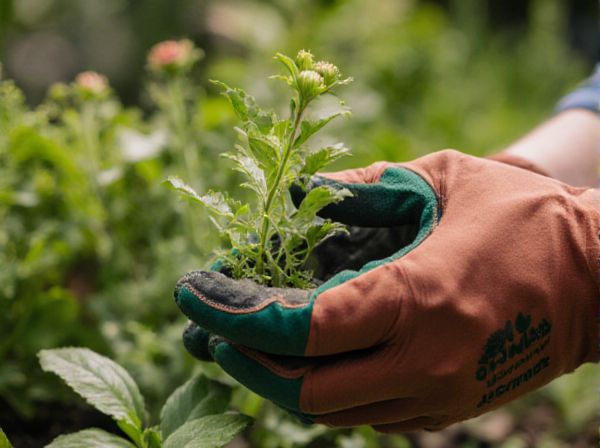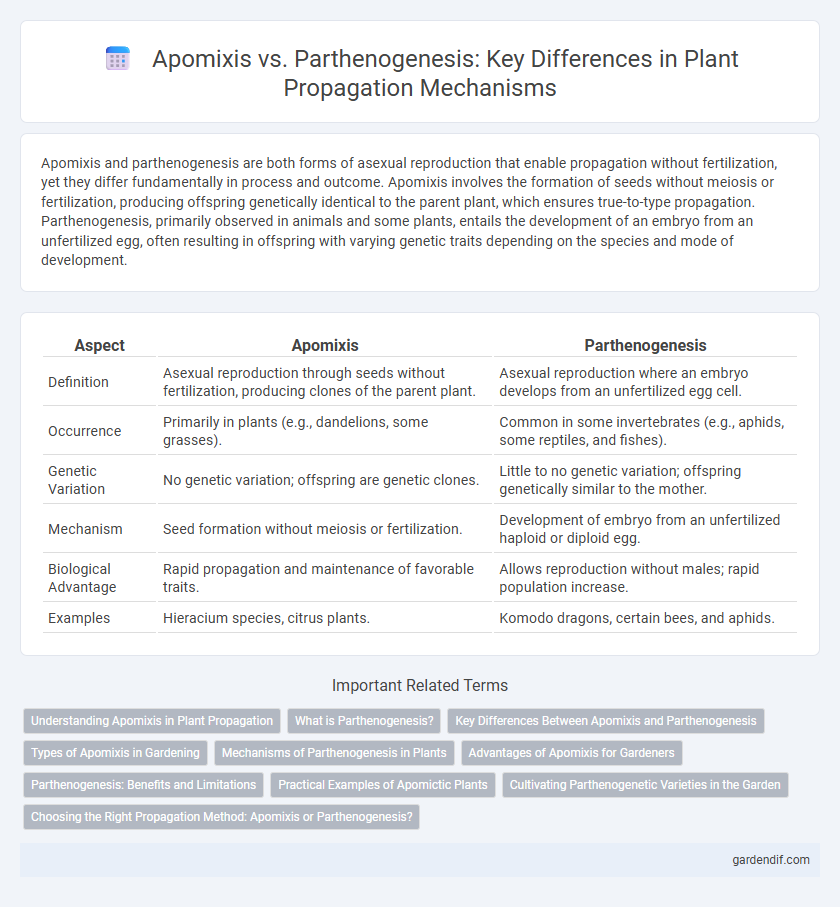
Apomixis vs Parthenogenesis Illustration
Apomixis and parthenogenesis are both forms of asexual reproduction that enable propagation without fertilization, yet they differ fundamentally in process and outcome. Apomixis involves the formation of seeds without meiosis or fertilization, producing offspring genetically identical to the parent plant, which ensures true-to-type propagation. Parthenogenesis, primarily observed in animals and some plants, entails the development of an embryo from an unfertilized egg, often resulting in offspring with varying genetic traits depending on the species and mode of development.
Table of Comparison
| Aspect | Apomixis | Parthenogenesis |
|---|---|---|
| Definition | Asexual reproduction through seeds without fertilization, producing clones of the parent plant. | Asexual reproduction where an embryo develops from an unfertilized egg cell. |
| Occurrence | Primarily in plants (e.g., dandelions, some grasses). | Common in some invertebrates (e.g., aphids, some reptiles, and fishes). |
| Genetic Variation | No genetic variation; offspring are genetic clones. | Little to no genetic variation; offspring genetically similar to the mother. |
| Mechanism | Seed formation without meiosis or fertilization. | Development of embryo from an unfertilized haploid or diploid egg. |
| Biological Advantage | Rapid propagation and maintenance of favorable traits. | Allows reproduction without males; rapid population increase. |
| Examples | Hieracium species, citrus plants. | Komodo dragons, certain bees, and aphids. |
Understanding Apomixis in Plant Propagation
Apomixis in plant propagation is a form of asexual reproduction where seeds develop without fertilization, ensuring genetically identical offspring to the parent plant. This process bypasses meiosis and fertilization, allowing for the preservation of desirable traits across generations. Understanding apomixis enables horticulturists to produce uniform crops efficiently while maintaining hybrid vigor and reducing reliance on sexual reproduction.
What is Parthenogenesis?
Parthenogenesis is a form of asexual reproduction where an embryo develops from an unfertilized egg, resulting in offspring genetically identical to the mother. This process occurs in various plants, insects, reptiles, and some fish species, enabling rapid population growth without the need for male fertilization. Unlike apomixis, which involves seed formation without fertilization, parthenogenesis specifically refers to embryo development from eggs without sperm contribution.
Key Differences Between Apomixis and Parthenogenesis
Apomixis involves asexual reproduction through seeds without fertilization, producing offspring genetically identical to the parent plant, while parthenogenesis is the development of an embryo from an unfertilized egg cell, common in certain animals and plants. A key difference lies in their biological context: apomixis occurs primarily in plants and bypasses meiosis, whereas parthenogenesis can occur in both plants and animals and may involve meiotic processes or remain ameiotic. Genetic variation is minimal in apomixis due to clonal reproduction, whereas parthenogenesis may result in some genetic recombination depending on the species and mechanism.
Types of Apomixis in Gardening
In gardening, apomixis involves asexual seed formation, ensuring offspring genetically identical to the parent plant, with key types including adventitious embryony, where embryos develop from somatic cells in the ovule, and gametophytic apomixis, subdivided into diplospory and apospory, both producing embryos from unreduced egg cells without fertilization. Parthenogenesis, by contrast, refers specifically to embryo development from unfertilized eggs but typically involves haploid offspring, differing from the clonal reproduction seen in apomixis. Understanding apomixis types allows gardeners to propagate desirable traits reliably, enhancing plant uniformity and stability in crops like citrus, mango, and dandelions.
Mechanisms of Parthenogenesis in Plants
Parthenogenesis in plants involves the development of an embryo from an unfertilized egg cell, bypassing the need for male gamete fusion. This mechanism is a form of asexual reproduction where the egg undergoes mitotic division, resulting in offspring genetically identical to the mother plant. Parthenogenesis contrasts with apomixis, which encompasses a broader range of asexual reproduction methods including embryo development from somatic cells, not solely from the egg cell.
Advantages of Apomixis for Gardeners
Apomixis allows gardeners to produce genetically identical plants without the need for pollination, ensuring uniformity and consistency in crop quality. This asexual reproduction method reduces dependency on environmental conditions for successful propagation, making plant breeding more reliable. Gardeners benefit from faster propagation cycles and the ability to preserve desirable traits across generations.
Parthenogenesis: Benefits and Limitations
Parthenogenesis enables plants to reproduce without fertilization, ensuring rapid and consistent propagation of desirable traits, which is especially beneficial in maintaining genetic uniformity in crops. This asexual reproduction method reduces dependency on pollinators and environmental conditions, enhancing stability in crop production. However, the lack of genetic diversity resulting from parthenogenesis can increase vulnerability to diseases and environmental stresses, limiting adaptability and long-term resilience.
Practical Examples of Apomictic Plants
Apomixis enables plants like citrus, mango, and dandelions to reproduce seeds without fertilization, maintaining genetic uniformity across generations. This asexual reproduction method is widely utilized in agriculture to preserve desirable traits in crops such as forage grasses (Poa pratensis) and citrus cultivars. Unlike parthenogenesis in animals, apomixis in plants bypasses meiosis, ensuring clonal offspring identical to the mother plant.
Cultivating Parthenogenetic Varieties in the Garden
Cultivating parthenogenetic varieties in the garden offers a reliable method for producing genetically uniform plants without fertilization, enhancing crop consistency and reducing dependency on pollinators. Parthenogenesis enables the development of fruit and seeds from unfertilized eggs, which accelerates propagation cycles compared to apomixis that involves asexual seed formation preserving the maternal genotype. Utilizing parthenogenetic cultivars supports sustainable gardening practices by promoting seedless fruit production and maintaining desired horticultural traits.
Choosing the Right Propagation Method: Apomixis or Parthenogenesis?
Choosing the right propagation method depends on the desired genetic uniformity and reproductive efficiency; apomixis produces offspring genetically identical to the parent, ensuring uniformity in traits, while parthenogenesis allows development from unfertilized eggs, promoting genetic variability. Apomixis is ideal for maintaining specific cultivars in agriculture and horticulture, providing consistent yield and quality without the need for fertilization. Parthenogenesis benefits breeding programs aiming for hybrid vigor and genetic diversity, as it enables seed production without pollination but with potential genetic variation.
Apomixis vs Parthenogenesis Infographic

 gardendif.com
gardendif.com